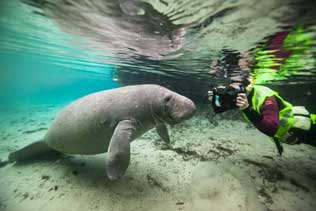
My next manatee photography workshop will be in February 2015
We will be in the water nearly all day with the manatees which gives you plenty of time to practice your techniques and get some really great shots. Unlike other underwater creatures that are gone in one exposure, manatees are slow and linger. Take advantage of this by planning each shot and doing some in the field analysis and learning from images you just made.
Getting a Great Shot of a Manatee Up for a Breath
The Situation:
There is a manatee asleep on the bottom near you. Regulations say that you are not allowed to disturb them – especially diving down to get pictures of them asleep. They can stay under for 10 minutes which is way to long to hover just underwater and wait. How do you get a good image of them coming up for a breath?
1) Choose a manatee who is facing such that there will be light on its face (not in the shade from a tree) and is preferably not facing such that you will be shooting into the sun.
2) Decide your angle; 3/4 shot, directly on, full side pose, vertical or horizontal camera position. Scan what will be the background and plan to place undesirable elements like people behind the manatee or out of frame.
3) Get into position and float relaxed. Think about your settings, take test shots, adjust. Take special note of the view of the sky through the water. The deeper you are the more sky will show. This may not be ideal.
4) When it is time, you will want to force some air out of your lungs which will make you sink a bit (you have already tested this and set your weights correctly). Push water up slowly but firmly with one hand to get you under – Do not move your legs or you will cloud your own picture and possibly freak out the manatee.
5) Watch the manatee. They usually have a “tell” when they are preparing to surface. Their body will rock a bit then begin to rise. Exhale and sink, snapping pictures and keeping your body still and compact to limit movement.
6) snap shots while the manatee is on the way up. Watch the framing of your shot to get the whole animal – nose to tail- in the shot.
7) Get a shot as he breaks the surface and takes in air. Then some on the way back down with the ripples on the surface. The manatee may fall pretty fast. Sometimes they dont get enough air and go right back up or linger. Just hold your breath and be still . Get the shot. You will have 10 minutes to rest and try again.
8) While you wait for the next breath examine your shots. Make a new plan. Try a different manatee if this one is not in a good spot.


